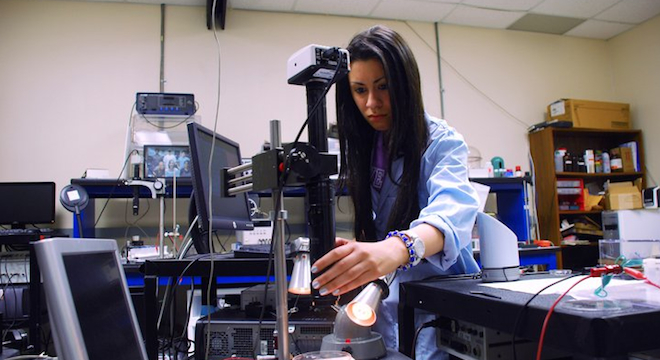Of course, it would be researchers in perpetually heat-stricken Dallas who would find a way to simulate one of nature’s most engaging heat-caused phenomena: the mirage.
Still, the practical demonstration of an “invisibility cloak” or “cloaking device” by professor Ali Aliev and his research team at the Alan G. MacDiarmid NanoTech Institute at the University of Texas at Dallas, is a sight to behold, as seen in the following video:
The incredible display is achieved by using transparent sheets of carbon nanotubes one-molecule thick, dunked in water. When the temperature of the sheets is increased rapidly by an electrical current, the sheet transfers the heat to the water in its immediate vicinity, causing light rays to bend away from the object behind it, rendering it invisible.
“Using these nanotube sheets, concealment can be realized over the entire optical range and rapidly turned on-and-off at will, using either electrical heating or a pulse of electromagnetic radiation,” Aliev explained to the Institute of Physics (IOP).
That’s the same way “the mirage effect” tricks your brain into thinking there is a pool of water in the middle of the road on a blazing sunny day. The hot road heats the air immediately above it to much higher temperatures than the rest of the air, refracting the light from the sky towards your eye.
His team published their findings in the IOP journal Nanotechnology on Tuesday.
Still, while the demonstration is undoubtedly attention-grabbing, its worth noting that science has promised advances in invisibility cloaks on numerous occasions in the past few years. For instance, in January 2009, scientists at Duke University announced they had created a nanoscale “metamaterial” cloak that they predicted could be used to bend visible light within six months. Obviously, that didn’t happen.
The Microsoft Kinect has been hacked to simulate invisibility cloaks via augmented reality.
More recently, British defense research company BAE Systems showed off its own “adaptive camouflage” for tanks, which are covered with tiny individual temperature-controlled “pixels” that can be adjusted to render the tank invisible to infrared.
We’ve reached out to Aliev to ask how his research differs from that which has come before and will update when we receive a response.









